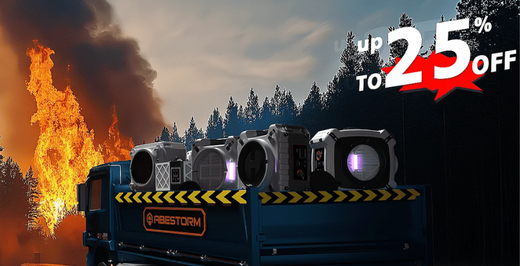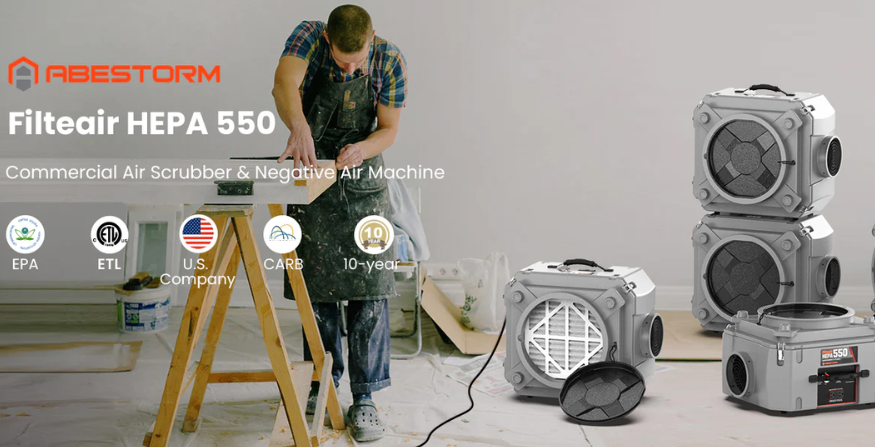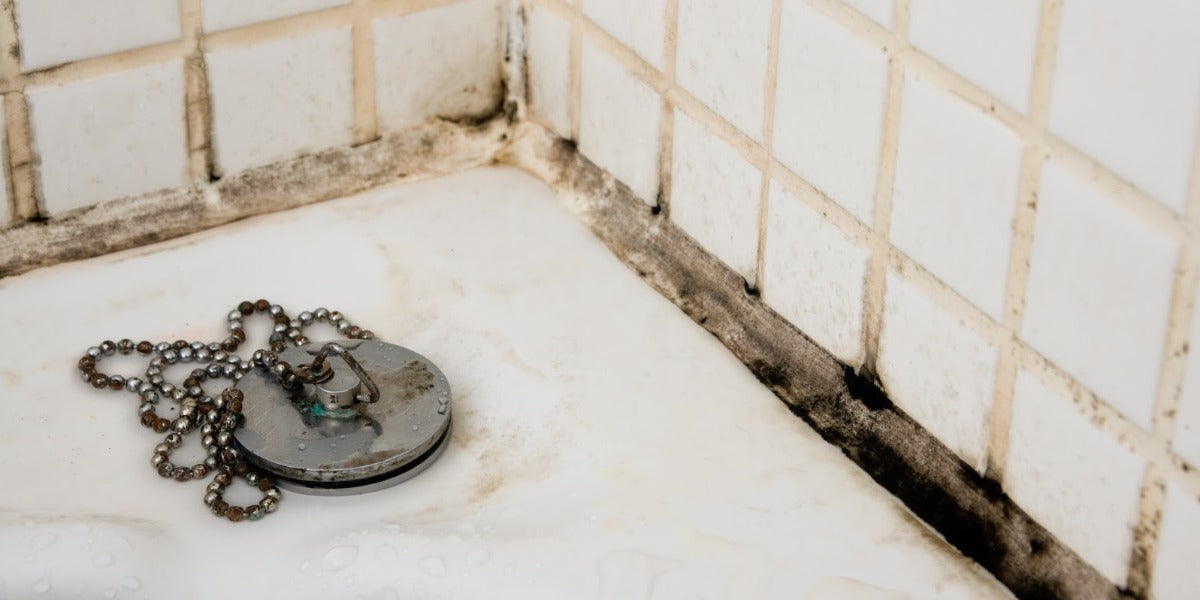Asthma affects millions worldwide, significantly impacting the quality of life by turning everyday environments into health hazards. As it is found that 25 million US citizens are suffering from asthma. Among these 60% of people have asthma due to allergies triggered by pet dander, pollen, allergens, etc. For those living with asthma, the home can either be a sanctuary or a source of discomfort, largely dependent on the presence of airborne allergens. Here comes the role of sophisticated technology in the form of an Abestorm Filteair HEPA Air scrubber to fight against these allergens. This blog explores its causes and provides effective asthma prevention strategies to reduce allergens in your home, highlighting the role of advanced air purification technologies such as Air Scrubbers and Abestorm Air Purifiers in creating a healthier living space.
Understanding Asthma and Its Triggers
Asthma is a chronic respiratory condition characterized by inflammation and narrowing of the airways, which can lead to difficulty breathing, coughing, wheezing, and tightness in the chest. These symptoms are often triggered by environmental factors that irritate the airways, and understanding these triggers is crucial for managing the condition effectively. In indoor environments, common triggers include dust mites, pet dander, mold spores, pollen, and tobacco smoke. Each of these has the potential to exacerbate asthma symptoms, making it essential to identify and control them within living spaces.
When individuals with asthma encounter these allergens, their immune system reacts disproportionately, treating these otherwise harmless substances as threats. This immune response triggers the release of substances that cause allergic symptoms and inflame the airways in the lungs. This inflammation can cause a narrowing of the airways and the production of excess mucus, which further obstructs breathing and can lead to an asthma attack. Managing indoor allergens is therefore not just about comfort—it's about preventing potentially serious health episodes that can result from uncontrolled asthma.
Common Indoor Allergens and Their Sources
Understanding the sources of indoor allergens is crucial for effectively managing and reducing their presence in the home. Here’s a closer look at typical allergens that can trigger asthma symptoms and the areas they are commonly found:
Dust Mites
Dust mites are among the most pervasive allergens in any home environment, thriving in warm, humid conditions. They primarily dwell in mattresses, bedding, upholstered furniture, and carpets. Minimizing dust mite exposure involves regular cleaning and the use of allergen-proof mattresses and pillow covers.
Pet Dander
Animals can bring joy to a home, but their dander (skin flakes) can be a significant asthma trigger. Pet dander is lightweight and can remain suspended in the air for a long time. Regular grooming of pets and maintaining clean living spaces are essential to control this allergen.
Pollen
While primarily an outdoor allergen, pollen can easily be carried indoors through open windows, doors, and on clothing. Using air purifiers like the Abestorm HEPA air purifier during pollen season can help filter out these allergens from the indoor air, providing relief to those with pollen allergies.
Mold
Mold grows in damp and poorly ventilated areas and can be particularly problematic in basements, bathrooms, and kitchens. Controlling humidity problems with dehumidifiers and ensuring good ventilation are effective ways to prevent mold growth and reduce asthma triggers.
By addressing these common allergens and taking proactive steps such as using the Abestorm 4 air purifier filter, homeowners can significantly reduce asthma symptoms and improve indoor air quality.
Role of Air Purifiers in Managing Asthma
Air purifiers are instrumental in filtering out the allergens that exacerbate asthma conditions. Let's explore how air purifiers like those offered by Abestorm are one of the proven asthma prevention strategies and how these can be integrated into your home to create a cleaner, healthier environment:
How Air Purifiers Work
Air purifiers use filters to trap and remove particles from the air, including those too small to see. The Abestorm HEPA air purifier uses a high-efficiency particulate air (HEPA) filter, which is capable of capturing 99.97% of particles as small as 0.3 microns. This includes most allergens like pollen, mold spores, dust mite debris, and pet dander.
Benefits of Abestorm Air Purifiers
The Abestorm air purifier filter is designed to provide maximum filtration by combining HEPA with activated carbon filters. This not only removes physical particles but also helps eliminate odors and volatile organic compounds (VOCs) that can irritate the airways. For homes with asthma sufferers, this means significantly cleaner air and reduced triggers for asthma attacks. Therefore, the Abestorm air purifier filter can prove your secret weapon in this war against allergens.
Using Air Scrubbers for Enhanced Air Quality
In addition to traditional air purifiers, Air Scrubbers provide a more robust solution by actively removing contaminants from large areas. Abestorm air purifiers and Air Scrubbers work together to maintain optimal air quality in your home, effectively reducing the risk of asthma flare-ups due to airborne allergens.
Implementing these air purification technologies can drastically reduce the amount of irritants in the home environment, making it a safer place for those with asthma and allergies. The next section will guide you on choosing the right air purification system tailored to your specific needs, ensuring you get the best protection against indoor allergens.
Choosing the Right Air Purification System
Selecting the best air purification system involves understanding the specific needs of your home and the severity of asthma conditions among its inhabitants. Here are some factors to consider when choosing an air purifier:
Assessing Air Purifier Filters
The efficacy of an air purifier largely depends on its filters. Look for models with HEPA filters, such as the Abestorm HEPA air purifier, which are renowned for its ability to trap ultrafine particles. Additionally, models that include Abestorm 4 air purifier filters offer an advanced level of purification, capturing a wider range of pollutants.
Coverage Area
Ensure that the air purifier's capacity matches the size of the room where it will be used. An undersized purifier won’t effectively clean the air in a large room, while an oversized purifier could consume unnecessary power. Check the manufacturer's recommended coverage area to guide your choice.
Features for Convenience and Efficiency
Consider air purifiers with features that add convenience and enhance performance, such as programmable timers, filter change indicators, and multiple fan speeds. These features can help you maintain the unit easily and customize its operation to suit your needs.
Noise Level
Since air purifiers are often used in bedrooms and living areas, opt for a model that operates quietly. This will help maintain a comfortable and disturbance-free environment, especially important during sleep hours.
Additional Strategies to Reduce Allergens
While air purifiers and air scrubbers play a pivotal role in controlling indoor allergens, combining them with other strategies can enhance your home’s overall allergen management:
Regular Cleaning
Frequent vacuuming with HEPA-filter-equipped vacuums, dusting with damp cloths, and washing bedding at high temperatures can significantly reduce the presence of allergens.
Manage Humidity
Maintaining indoor humidity below 50% can help inhibit the growth of mold and dust mites. Use dehumidifiers in high-humidity areas like bathrooms and kitchens to keep the air dry and less hospitable to allergens.
Minimize Clutter
Reducing clutter in your home can decrease dust accumulation and make cleaning easier, reducing the places where allergens can hide.
Conclusion
Understanding asthma triggers and effectively reducing allergens in your home are crucial steps toward creating a healthier living environment. By integrating advanced air purification technologies such as Abestorm air purifiers and combining them with thorough household cleaning practices, you can significantly mitigate asthma symptoms and improve your quality of life. Remember, every step taken towards purifying your home's air is a step towards breathing easier and living better.
Ready to transform your home into a haven free from allergens?
Visit Abestorm.com today to explore our range of advanced air purifiers and find the perfect solution to protect your family from asthma triggers. Take control of your indoor air quality now and breathe easier with Abestorm!









Shop For Dehumidifier